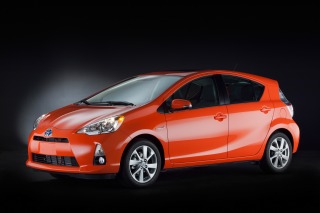
Since hybrids came on the market, car buyers have faced a cold, hard fact: To get great mileage, they have to pay more for a hybrid than they would for a traditional gas-powered car.
Even Toyota’s best-selling Prius costs thousands more than a Toyota Yaris or Corolla, two cars that go from point A to point B while carrying five people.
The 2012 Toyota Prius c obliterates the hybrid price penalty with a $19,000 starting price and a segment-leading 50 mpg combined.
If that value proposition were the 2012 Toyota Prius c’s only feat, it would likely still be a sales success, but the mini-Prius is also surprisingly roomy — and has a comfortable ride and an impressive array of standard features.
The hybrid for the masses has arrived, and I honestly think Toyota won’t be able to build enough of them to meet demand come March, when the car goes on sale. It comes in four trim levels, numbered One through Four.
Hybrid Performance
Like the familiar Prius liftback, the Prius c features Toyota’s Synergy hybrid system, which has been refined to the point where we’ve observed its 50 mpg estimate over hundreds of real-world miles since the liftback’s 2009 debut.
The Prius c teams a smaller four-cylinder gasoline engine — 1.5 liters and 73 horsepower — with an electric motor, for a combined 99-hp rating. The battery pack features fewer battery cells — 120 versus 168 — so it can fit tightly underneath the rear seats instead of under the cargo area, where it is in the traditional Prius. Other fuel-saving elements have also been downsized, like a smaller electric power steering system, to aid efficiency.
Mileage ratings are 53/46 mpg city/highway, and 50 mpg combined. The regular Prius gets an EPA-estimated 51/48 mpg and the same combined rating.
In terms of driving performance, the Prius c is about as exciting as you might predict, which is not very. But compare it with traditional high-mileage subcompacts like the Hyundai Accent and Ford Fiesta, and it gives up little ground, despite its sub-100-hp rating. Toyota said it can reach 60 mph in 11.5 seconds, but the car seemed faster merging onto the highway.
During a number of driving routes of between 20 and 50 miles apiece, the worst mileage my driving partner and I returned was 46.6 mpg, while the best was 54.4 mpg. The tests were done in hilly California in optimal 60-degree weather. While coasting downhill, you can shift the Prius c into a B mode for aggressive brake regeneration to fill the hybrid battery to its maximum level.
At the bottom of the hill, through residential streets, we engaged EV mode, which runs the Prius c on electric power only. Even in this mode, keeping the gas engine from activating requires slow and steady acceleration that would aggravate anyone behind you in traffic. Nor can you exceed 25 mph. It took practice, but both of us were able to travel a few miles in EV through a busy downtown area and through a few quiet streets.
On one route, using the B setting and EV mode, we traveled nearly 10 miles and returned 99.9 mpg.
Then we headed back uphill.
A hybrid isn’t a magical car. The Prius c’s tiny engine strained going up steep hills — as do many subcompacts, like those mentioned above — and mileage dropped significantly. That said, the 46 mpg figure we hit was in the top trim level, the Four, which we pushed pretty hard. It was also equipped with optional 16-inch alloy wheels, which come in a package that also includes a slightly more aggressive suspension and steering system, and we wanted to see how fun the most fun version of the c could possibly be.
The fact that we accelerated as aggressively as any driver would, including on the longest highway stretch of the day, and still returned 46 mpg was as impressive as the 99.9 mpg we’d already marveled at.
The Prius c Four handled better than the rest of the lineup without giving up what is a remarkably comfortable ride. The c’s 100.4-inch wheelbase is longer than those of the Yaris and Fiesta (about 98 inches) which helps in terms of ride comfort. The Accent’s 101.2-inch wheelbase is slightly longer. The Prius c is slightly shorter from bumper to bumper than the Fiesta and Accent hatchbacks, and it’s a few inches longer than the four-door Yaris hatchback.
Steering was less sharp in the other Prius c models, with much more play in the steering wheel. While I wouldn’t call any of the trims a fun car to pilot through twisty roads, they’re more than adequate for the typical commuter.
The standard low-rolling-resistance tires offered decent grip and didn’t add excessive road noise. Overall, road noise was better than average for the subcompact class.
The Prius c rides and feels worlds apart from the rough-riding Honda Insight — a dedicated hybrid model at a similar price with significantly lower fuel efficiency. The two have nearly identical wheelbases, but the Prius c is 15 inches shorter overall. The Prius c also weighs nearly 250 pounds less.
The Prius c’s braking was typical of hybrids with regenerative brakes. They feel spongy as the hybrid system engages to recapture energy for the battery. But at least it felt like a consistent, predictable sponge. I find the entire Toyota lineup generally lackluster in terms of braking feel, and the Prius c stopped more responsively than the non-hybrid 2012 Camry I recently tested.
Interior
When you think of a $19,000 subcompact car with an advanced hybrid system — and a backseat — you expect the interior to be low-rent. That’s not the case here. While the base Prius c One is equipped with seating materials that could have been on a 1982 Corolla, the rest of the cabin materials are on par with competitors like Ford and Hyundai’s sub-$20,000 cars.
Plastics on all trim levels have a variety of patterns and textures. There are so many varying grains on the dash that there doesn’t seem to be much rhyme or reason to them. Wouldn’t one or two have sufficed versus five or six?
But the patterns — along with the nice color accents in higher trims — exude a funkiness that shoppers might appreciate.
The interior space is a big surprise. Passenger volume is 87.4 cubic feet, which tops the larger Insight’s 85 cubic feet and the Fiesta’s 85.1 cubic feet, while falling short of the Accent’s 90.1 cubic feet. The Accent is one of the more spacious-feeling subcompacts on the market.
At 5-foot-10, I was perfectly comfortable in the driver and front passenger seats over hours of driving. That included the Prius c One’s low-grade fabric seats as well as the Four’s SofTex seats. Standard on that trim level, SofTex is a synthetic leather that’s purportedly ecologically friendly. The Four’s seats are also heated and sport their own intricate graining.
Each seat type featured nice bolsters and a fair amount of thigh support considering the generally upright seating position.
While a 6-foot-7 passenger looked comical crammed into the backseat, I fit just fine behind the driver’s seat positioned where I’d put it to drive. I had inches of knee room and more than enough headroom. However, the rear seatbacks lean back more than I like, a design to ensure passengers’ heads fit under a concave area in the roof liner above the cargo area.
Spread around the cabin for both the driver and passengers were numerous cubbies, all of which were large enough for smartphones or larger items.
The cargo area is rated 17.1 cubic feet, but it appeared much smaller than that. After checking the numbers with the Hyundai Accent, rated at 21.2 cubic feet, and the Ford Fiesta, at 15.4 cubic feet, I felt satisfied that the Prius c does fall right between the two. However, an average family’s grocery trip would likely overwhelm the space, as would taking a couple of friends to the airport. The backseat does fold down, either in one piece — in the Prius c One — or in a 60/40 split in the other trim levels. Most likely, that utility will be enough for buyers of a vehicle this size.
Features & Technology
The Prius c comes decently equipped with features you might not expect in a sub-$20,000 car, including Bluetooth, hill start assist and USB inputs. However, it’s the hybrid trip computer that will wow buyers of every trim level.
The vibrant 3.5-inch screen sits dead center in the instrument panel, which itself is dead center on top of the dashboard. It depicts the typical trip computer that hybrid drivers will recognize, including a graphic to show whether your driving style is using engine power or electric power, or if it’s recharging the battery. The Prius c also features a new driving “score” to show how efficiently you’re driving.
But that’s not what will wow: Drivers can input both the current price of gas and the mileage of another car to show how much money the Prius c is saving them, in real time.
The competing car would theoretically be the car you didn’t buy instead of the Prius c, or your household’s second car or truck. The bigger the difference in combined mileage, the more money you see accumulating in a variety of displays, whether for a single trip or over months and years.
The rest of the car’s features can be broken down by trim level. Very few options are available.
The Prius c One starts at $18,950 (before a $760 destination charge) and includes a USB port, Bluetooth phone and audio, hill start assist, 15-inch steel wheels, a tilt/telescoping steering wheel, a four-speaker stereo and steering-wheel-mounted audio, climate and phone controls.
The Prius c Two starts at $19,900 and adds a six-speaker stereo, a six-way adjustable driver’s seat, a 60/40-split folding backseat, cruise control and a center armrest.
The Prius c Three starts at $21,635 and adds navigation and Toyota’s Entune system, body-colored door handles, a Touch Tracer display, push-button start, and keyless entry and cargo area.
The Prius c Four starts at $23,230 and adds 15-inch alloy wheels, heated SofTex front seats, fog lamps and body-colored mirrors with integrated turn signals.
The only available options are 15-inch alloy wheels and a power moonroof for the Prius c Three and 16-inch alloy wheels with an upgraded suspension and moonroof for the Prius c Four.
I anticipate most shoppers will opt for the Two trim level in order to get creature comforts like the stereo, a height-adjustable front seat and higher-quality cloth seating. While the upgraded seats don’t offer much difference in terms of comfort, their appearance improves upon the base model’s seats.
The other two trim levels’ relatively high prices may dissuade shoppers interested in the new “inexpensive” Prius, considering they can get into similarly equipped traditional gas cars for far less.
The standard navigation system on the Prius c Three and Four is similar to the one found in the new Camry, which I think is better for entertainment uses, like iPod and Pandora internet radio integration, versus reading maps or finding a proper route to a destination. It’s a good system overall, but with a relatively small 6.1-inch touch-screen. The stereo interface in other trim levels is a pretty straightforward one, with knobs and buttons and a small text display for song and artist information.
The six-speaker stereo in the Two, Three and Four trims isn’t powerful, but its clarity is good. I’m guessing Toyota tried to save some weight with the speakers, sacrificing sound quality in favor of lightness. That’s an easy fix for music-conscious customers, but I’d like to see a better green-friendly stereo, at least in the top trim level.
Safety
The Prius c comes standard with nine airbags. In addition to frontal and side-impact airbags for the front seats and curtains for the front and rear occupants, there’s a driver’s knee airbag and two seat-cushion airbags for the driver and front passenger. These airbags don’t directly protect occupants; they inflate to better position the driver and passenger in relation to the other airbags in the car in the event of a crash.
Neither the National Highway Traffic Safety Administration nor the Insurance Institute for Highway Safety had crash-tested the Prius c as of this writing.
Prius c in the Market
Before driving the Prius c, I already firmly believed that no matter what I discovered behind the wheel, buyers would line up for the car because of its price and impressive mileage figures.
The pleasant surprises I found in terms of ride quality, spaciousness and features only cemented that prediction. Until another automaker — Asian, domestic or European — can find a way to offer this level of value and efficiency, there simply won’t be a competitor for the Prius c.































